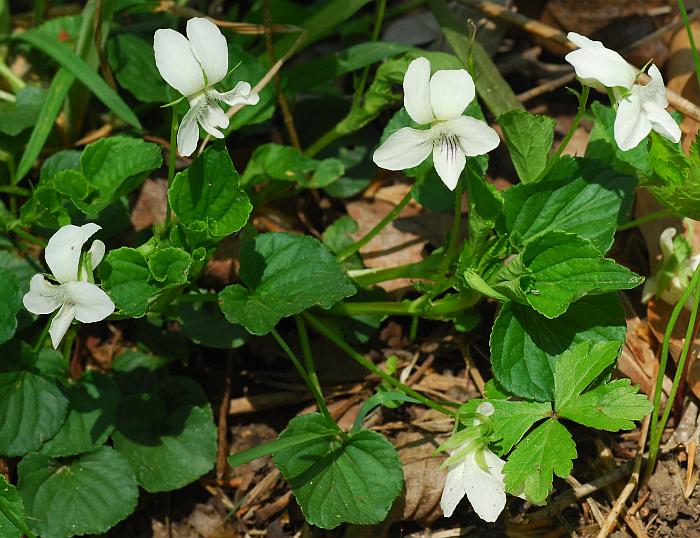Viola striata Aiton
Pale Violet

Native
CC = 3
CW = -3
MOC = 53
© SRTurner
Viola striata AitonPale Violet | |
 |
Native CC = 3 CW = -3 MOC = 53 |
© SRTurner |
|
Family - Violaceae Habit - Perennial forb with a slender to stout, prostrate to ascending rhizome 2-4 mm thick. Stems - Ascending, to 40 cm, sometimes from a spreading base, sometimes multiple, glabrous.
Leaves - Alternate, sometimes appearing subopposite, and also basal at flowering, mostly long-petiolate, the petiole to 5 cm long, glabrous. Stipules relatively large and conspicuous, herbaceous, free from the petiole, the margins with a fringe of relatively slender, deep teeth or lobes. Leaf blades 1.0-5.5 cm long, unlobed, broadly ovate to heart-shaped, narrowly angled or tapered at the tip, truncate to cordate at the base, the margins evenly scalloped or bluntly toothed, the surfaces glabrous or sparsely hairy on the upper surface.
Inflorescence - Solitary flower from leaf axil, on a stalk to 8 cm long, not or only slightly overtopping the leaves, glabrous, curved at apex, with two narrow bracts in upper half, these to 9 mm long, 1 mm broad. Flowers - Sepals 7-12 mm long, lanceolate, narrowly angled to a sharply pointed tip, the margins sometimes minutely hairy, the basal auricles well-developed. Corollas 8-13 mm long, the petals oriented forward with arched or outward-curved apical portions, longer than the sepals, white to pale cream-colored, the lower petal usually with dark purple veins, the lateral petals bearded on the upper surface with slender hairs, the lowermost petal glabrous on the upper surface, the spur well-exserted beyond the sepal auricles, relatively stout. Stamens 5, connate around ovary, not exserted, typically not visible without dissection of the flower. Style slender, bent at the tip. Ovary conic, glabrous. Cleistogamous flowers also produced.
Fruit - Capsules 3-9 mm long, broadly ellipsoid to ellipsoid, green, drying to tan to olive-colored, the surface glabrous. Seeds 1.8-2.0 mm long, tan.
Flowering - April - June. Habitat - Bottomland and mesic forests, streambanks, fens, bases and ledges of bluffs, prairies, glades, savannas, fencerows and roadsides. Origin - Native to the U.S. Lookalikes - V. lanceolata, V. pallens, V. maclocskeyi. These species all lack stems and fringed stipules. Other info. - This common spring wildflower occurs in the western and southern 2/3 of Missouri. Beyond Missouri its range extends mainly eastward and northward, into New England and Canada. It is easily identified, being the only Missouri stemmed violet with white flowers. Even without flowers it can be identified by the distinctive lacerate stipules. It is often abundant in disturbed areas such as frequently flooded alluvial areas and woodland paths. It is a calciphile with an affinity for moist to wet silty loam soils. Steyermark remarked that it grows well in woodland gardens. Photographs taken in the Ozark National Scenic Riverways, 5-24-03 (DETenaglia); also at Rockwoods Range Conservation Area, St. Louis County, MO, 4-29-2011, Young Conservation Area, Jefferson County, MO, 4-18-2015, Canaan Conservation Area, Gasconade County, MO, 4-26-2021, and at Northwest Sports complex, Jefferson County, MO, 5-10-2021 (SRTurner). |